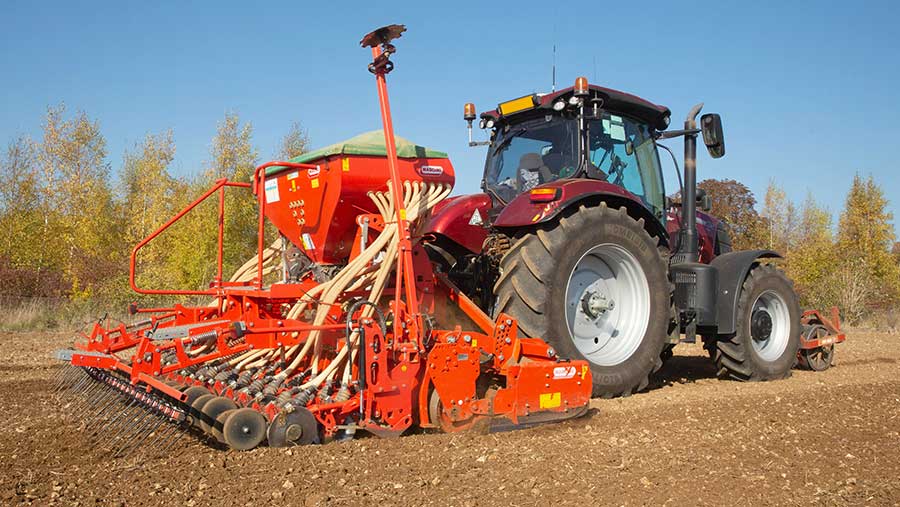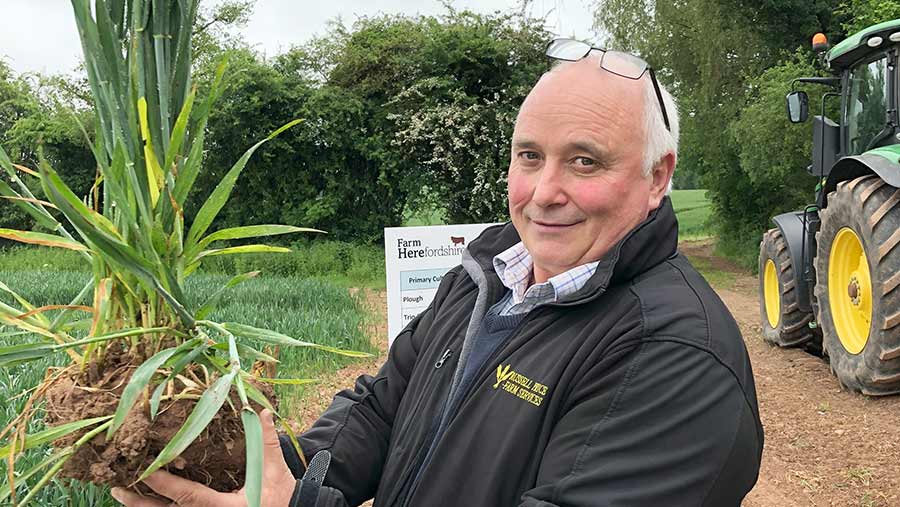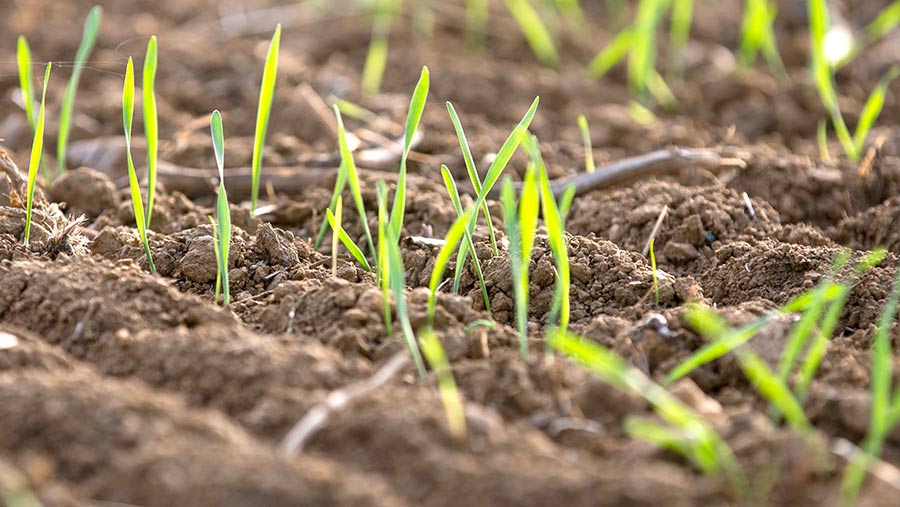On-farm establishment trial shows best system in a dry year
 © Tim Scrivener
© Tim Scrivener Dry conditions for the second year in a row have highlighted the importance of establishment method.
Systems which allowed crops to get their roots down in search of moisture were the best performing.
There is a huge array of crop establishment kit to choose from, from ploughing to direct drilling with many combinations in between.
However, it is not necessarily a case of picking the cheapest system or the one delivering the highest yields.
There are practical factors to consider such as performance in contrasting wet and dry seasons.
See also: Pros and cons of 6 different OSR establishment techniques
Other farm-specific pressures, such as grassweeds, pests, labour availability, rotation and soil type – will also have a bearing on the final choice.
On-farm trials
To identify the right system for his farm, AHDB joint Herefordshire Monitor Farmer Russell Price is hosting an on-stablishment trial.
Having started in 2016 with oilseed rape, the study is now in its second year of winter wheat.
Farm Facts
- Russell Price Farm Services is based at Town Farm, Castle Frome, where the business combines farming with contracting and machinery sales.
- With 705ha of arable crops, Mr Price is growing winter wheat, oilseed rape, beans, barley, grass seed, potatoes and broccoli.
- He also has 40ha of grassland, pedigree Hereford cattle and tack sheep.
- There are eight full-time staff, two office workers, eight sub-contractors and seasonal operators.
Six different establishment methods are being compared side-by-side in 24m-wide blocks, with the results accounting for labour requirements and costs as well as yield.
Costs of the systems vary by £50/ha, going from £85/ha to £135/ha. In 2018, the highest-yielding plot used a traditional plough and combination drill regime, but it was also one of the most expensive at £122/ha (see table).
An average yield of 11.56t/ha was achieved across the trial, from a 12 October drilling date.
This year, the work is being repeated in a second wheat situation, with the combination drill treatments already showing a visual benefit with a more even establishment.
2018 trial results |
||||
| A Trio cultivator followed by a combi drill had the lowest cost of the six establishment systems being compared on the AHDB Hereford Monitor Farm in last year’s dry conditions | ||||
|
Primary cultivator |
Secondary cultivator |
Labour (hours/ha) |
Cost (£/ha) |
Yield (t/ha) |
|
Plough |
Combi drill |
0.75 |
122 |
12.25 |
|
Plough |
Disc drill |
0.7 |
129 |
11.97 |
|
Trio cultivator |
Combi drill |
0.35 |
85 |
11.76 |
|
Trio cultivator |
Disc drill |
0.96 |
135 |
11.71 |
|
Stubble cultivator |
Strip till drill |
0.4 |
90 |
11.46 |
|
Stubble cultivator |
Direct drill |
0.5 |
115 |
11.11 |
Weather effects
For Mr Price, the trial has demonstrated that conditions at drilling do have an influence on establishment success, with rooting being variable across the different systems.
“If I had to choose just one system for my farming operation, it would be strip-till, even though coping with residues can be a challenge,” he says.
“In these plots, the strip-till crops have a better root mass, probably as a result of the leading tine.
“The combination and disc drills have also given good results this year, which seems to be because the deeper cultivation has helped roots to grow down.”
He recognises that in wet conditions they may not have done as well. “One of my concerns is whether or not they cause a pan when soils are saturated.”
The direct drilled plots are slightly tighter in the surface zone and have a shallower root mass, he adds.
“There aren’t as many roots getting through to depth. The importance of tilth has shown up – a surface cultivation was very appropriate for last autumn.”
Having hosted the trial for three years, he has also seen that crop cosmetics are no guide to final yields.
“One of the first lessons to come from the work was that looks are not a reliable indication of results, especially with oilseed rape,” he says.
“We’ve seen the good, the bad and the ugly in terms of crops. Sometimes it’s the ugly ones which come through with the highest yield or margin.”
Soil structure
Independent soils consultant Philip Wright points out that many soils have benefited from last summer’s dry weather, forming both vertical and horizontal cracks and naturally re-structuring.
As a result, crop roots have been able to penetrate the soil profile and earthworms have also been able to make their invaluable contribution, even where the cultivation method means that soils are normally tighter in the surface zone.
“Even though we’ve had a helping hand, it’s still important to consider the effects on soil from your operations,” he says. “You can be trafficking as much as 50% of the field if you are using a combination drill.”
A simple way of addressing this and preventing compaction is to set tyres at the lowest possible pressure, at 0.7bar or less, he advises. “The roots of most crops will get through this.”

Russell Price
For some, choosing the right crop establishment approach is being complicated by the trend for later drilling, he warns.
“As the drilling window gets pushed back to help with blackgrass control, it tends to coincide with wetter conditions. In this scenario, it’s still important to avoid too much soil disturbance, or else blackgrass seeds get the stimulation they need to germinate.”
A competitive crop is a must where blackgrass is a threat, he stresses. “If you’re wedded to a combination drill, you will need to think about the best way to use it. Disturbing the soil will give weed seeds the start they need.”
Mr Wright believes that with enough enthusiasm, any soil can be direct drilled. “Cover crops will help you get there quicker, if that’s your aim and there’s a physical barrier in the soil.
“As one of the cheapest systems, it also gives you the leeway if you do need to do some loosening once in a while.”
Future soil management
Payment for results is likely to be the basis for any future government support, with soil health being one of the targets, says Kate Speke-Adams of the Wye and Usk Foundation.
Natural capital, which growers are not being paid for currently, is described as our natural resources and is the source of ecosystem services such as clean water and fresh air, she explains.
“Drinking water, flood prevention and carbon capture all come into this category,” she says.
“It’s why parameters such as soil organic matter are important at the field level, because it determines how much water a soil can hold.”
Cultivations can have an almost immediate effect on soil organic matter content, she says, with the reduced-cultivation plots in the trial having 0.5% more organic matter than the traditionally cultivated areas.

Soil health is expected to become a key metric for support payments © Tim Scrivener
“That was measured just after the crop had gone in. So the trend was there in a very short space of time, showing what is possible.”
Similarly, carbon capture or storage is influenced by cultivation choices.
“In the direct drilled plots, we are storing 9kg/sq m of carbon, whereas the cultivated plots have 7kg/sq m.”
If future government policy means that farmers are given carbon sequestration goals to work towards, they will need to make appropriate choices, she says.

